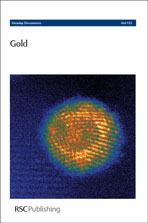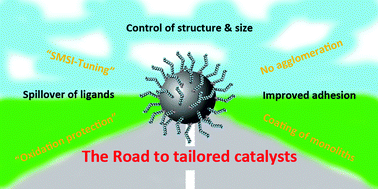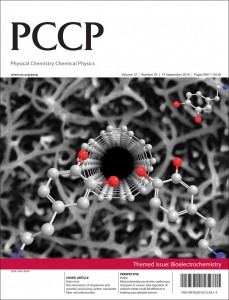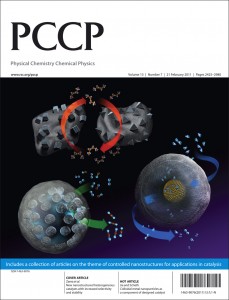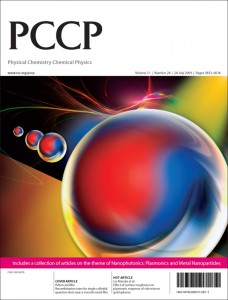 Physical Chemistry Chemical Physics (PCCP) Advisory Board member Professor Paul Mulvaney, an expert in the field of nanoscale chemistry, has picked his favourite articles recently published in this area in PCCP.
Physical Chemistry Chemical Physics (PCCP) Advisory Board member Professor Paul Mulvaney, an expert in the field of nanoscale chemistry, has picked his favourite articles recently published in this area in PCCP.
Read Professor Mulvaney’s Editor’s choice selection, along with his comments on each article, for free today:
A timely review of the rapidly developing field of a nanocrystal self-assembly. This perspective discusses the new techniques emerging and the exciting new materials created. The focus is on thiol derivatized gold particles but will be of interest to anyone interested in nanocrystal assembly:
Functional noble metal nanoparticle superlattices grown at interfaces
Keisaku Kimura and Thalappil Pradeep
DOI: 10.1039/C1CP22279A
A review of electron transfer dynamics of nanoparticle-modified electrodes. This review certainly suggests wet-chemical electronics is coming of age:
Electrochemical charge transfer mediated by metal nanoparticles and quantum dots
Gabriela P. Kissling, David O. Miles and David J. Fermín
DOI: 10.1039/C1CP21996K
An in-depth review of the controversy surrounding the detection and measurement difficulties associated with multi-exciton generation. The article suggests some novel ways forward:
Multiple exciton generation in nanocrystal quantum dots – controversy, current status and future prospects
David J. Binks
DOI: 10.1039/C1CP20225A
An exciting review by leading researchers of the issues involving energy relaxation during NC–NC interactions:
Energetics and dynamics of exciton–exciton interactions in compound colloidal semiconductor quantum dots
Zvicka Deutsch, Assaf Avidan, Iddo Pinkas and Dan Oron
DOI: 10.1039/C0CP02253E
Catalysis is one of the outstanding areas in physical chemistry where empirical breakthroughs lead theory and understanding. This review tries to capture the main trends in the application and design of nano crystals in catalysis. A good read for those who think catalysis can’t be tackled rationally:
Colloidal metal nanoparticles as a component of designed catalyst
Chun-Jiang Jia and Ferdi Schüth
DOI: 10.1039/C0CP02680H
An interesting paper, which finds further evidence for multi-exciton generation in PbS:
Electronic and surface properties of PbS nanoparticles exhibiting efficient multiple exciton generation
Samantha J. O. Hardman, Darren M. Graham, Stuart K. Stubbs, Ben F. Spencer, Elaine A. Seddon, Ho-Ting Fung, Sandra Gardonio, Fausto Sirotti, Mathieu G. Silly, Javeed Akhtar, Paul O’Brien, David J. Binks and Wendy R. Flavell
DOI: 10.1039/C1CP22330E
Freund and colleagues demonstrate size dependent binding of CO to Pd. Given the importance of CO removal as a pollutant, this is a particularly exciting piece of work that also shows systematic understanding of “nanoscale” effects in catalysis is possible:
Adsorption energetics of CO on supported Pd nanoparticles as a function of particle size by single crystal microcalorimetry
J. M. Flores-Camacho, J.-H. Fischer-Wolfarth, M. Peter, C. T. Campbell, S. Schauermann and H.-J. Freund
DOI: 10.1039/C1CP21677E
Cationic surfactants normally present in these rods makes their use cumbersome. Hu and Gao show that the use of amphiphilic coatings helps gold nanorods to work efficiently:
Multilayer coating of gold nanorods for combined stability and biocompatibility
Xiaoge Hu and Xiaohu Gao
DOI: 10.1039/C0CP02434A
The authors show that interactions between nanocrystals affects the tunneling current between an STM tip and the NCs:
Controlled electrostatic assembly of quantum dots vis-à-vis their electronic coupling and transport gap
Batu Ghosh and Amlan J. Pal
DOI: 10.1039/C0CP02729D
This paper shows that a single nanoparticle can be detected when it is driven through a nanopore electrophoretically. Particularly interesting is the role of the double layer around not just the pore but also the particle in determining the sensitivity of this process:
Electrokinetic particle translocation through a nanopore
Ye Ai and Shizhi Qian
DOI: 10.1039/C0CP02267E
Publishing work of the highest quality in the broad fields of physical chemistry, chemical physics and biophysical chemistry, PCCP is the ideal place to publish your research.
On behalf of the Editorial board we invite you to submit your best work to PCCP.
PCCP now offers you the chance to publish your accepted article as an Accepted Manuscript. This means that your research is available, in citable form, to the community even more rapidly. Click here to find out more.













